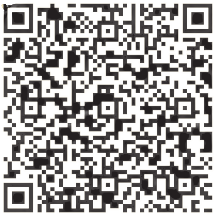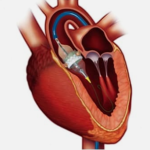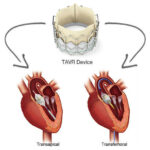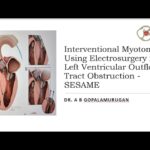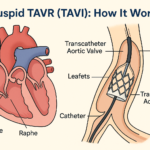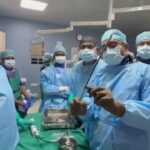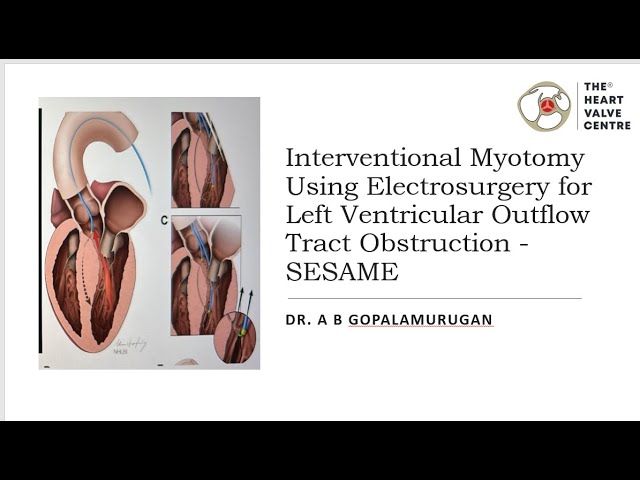 25 September, 2025
25 September, 2025
Interventional Myotomy Using Electrosurgery for LVOT Obstruction – SESAME
Heart diseases are among the leading causes of morbidity and mortality worldwide, and India is no exception. While many cardiac conditions are treatable with medicines, stents, or surgery, some conditions require cutting-edge innovations. One such condition is Hypertrophic Obstructive Cardiomyopathy (HOCM), where the heart muscle becomes abnormally thickened, particularly the septum (the wall between the left and right sides of the heart).
This thickened muscle can obstruct blood flow from the Left Ventricle to the Aorta, creating what is called Left Ventricular Outflow Tract (LVOT) Obstruction. Patients often present with chest pain, breathlessness, palpitations, fainting spells, and in severe cases, sudden cardiac death.
Traditional management includes medications like beta-blockers and disopyramide, as well as procedures like Alcohol Septal Ablation (ASA) or Surgical Septal Myectomy. However, not all patients are suitable candidates for these treatments. For them, a new ray of hope has emerged – SESAME (SEptal Scoring Along the Midline Endocardium).
Pioneered in India by Dr. A. B. Gopalamurugan, Senior Interventional Cardiologist & Electrophysiologist at The Heart Valve Centre, Chennai, SESAME represents a landmark advancement in interventional cardiology.
Understanding the Challenge: HOCM and LVOT Obstruction
-
Hypertrophic Obstructive Cardiomyopathy (HOCM) occurs due to abnormal thickening of the heart muscle, often genetically inherited.
-
This thickening, especially in the interventricular septum, leads to obstruction of blood flow from the left ventricle.
-
Patients may experience:
-
Shortness of breath on exertion
-
Chest pain (angina)
-
Palpitations and arrhythmias
-
Dizziness or fainting spells
-
Increased risk of sudden cardiac arrest
-
While medicines and implantable cardioverter defibrillators (ICDs) provide some relief, patients with severe obstruction often remain symptomatic and require more definitive intervention.
Traditional Approaches and Their Limitations
-
Alcohol Septal Ablation (ASA)
-
Involves injecting alcohol into a small artery supplying the septum, causing controlled damage and thinning of the heart muscle.
-
Limitation: Not all patients have suitable arterial anatomy for ASA.
-
-
Surgical Septal Myectomy
-
Considered the gold standard; involves open-heart surgery to cut away thickened heart muscle.
-
Limitation: Requires open surgery, high surgical risk, not suitable for elderly or fragile patients.
-
-
Medical Therapy
-
Medications reduce symptoms but do not eliminate the obstruction in many patients.
-
This created a clear gap in treatment options – a minimally invasive, catheter-based therapy for LVOT obstruction in high-risk patients.
What is SESAME?
SESAME (SEptal Scoring Along the Midline Endocardium) is a novel percutaneous electrosurgical myotomy technique.
-
A catheter and wire system is introduced into the heart via minimally invasive access.
-
Using Astato wire with Corsair microcatheter, the septum is carefully scored along the midline.
-
A “Flying V” configuration is used to loop and snare the wire, concentrating diathermy (electrical energy) at the target site.
-
This energy precisely cuts the basal septum, relieving the obstruction.
Unlike open surgery, SESAME is performed without opening the chest and allows for faster recovery.
Case Highlight: A 65-Year-Old Patient
One of the landmark cases demonstrating the power of SESAME involved a 65-year-old woman with:
-
HOCM, ICD implanted for ventricular tachycardia
-
Severe symptoms of LVOT obstruction
-
No suitable septal artery for Alcohol Septal Ablation
-
Non-responsive to medications like beta-blockers and disopyramide
Treatment Plan
-
Pre-procedure imaging (CT, CMR) helped plan the orthogonal trajectory for septal scoring.
-
SESAME was performed successfully using advanced electrosurgical techniques.
-
Result: The patient experienced significant relief from obstruction and improved quality of life without undergoing open-heart surgery.
Evolution of Electrosurgery in India
Since 2020, Dr. A. B. Gopalamurugan and his team have led the way in introducing electrosurgical techniques in India, making the country a global pioneer in advanced interventional cardiology.
Key Milestones:
-
CAVO-AORTIC Approach (March 2020 – Chennai)
-
India’s first cavo-aortic access using electrosurgery for PCI, TEVAR, and TAVR.
-
-
SESAME Technique
-
Percutaneous septal myotomy for LVOT obstruction in HOCM.
-
-
LAMPOON (March 2022 – Chennai)
-
Intentional laceration of the anterior mitral leaflet using electrosurgery to prevent LVOT obstruction during TMVR (Transcatheter Mitral Valve Replacement).
-
-
Other Electrosurgical Innovations
-
Techniques developed in collaboration with the National Heart, Lung, and Blood Institute and Robert Lederman’s lab.
-
These achievements demonstrate India’s ability to deliver world-class cardiac innovation to patients domestically.
Why SESAME is a Game-Changer
-
Minimally invasive – avoids open-heart surgery
-
Precise targeting – uses imaging and electrosurgical energy for accuracy
-
Rapid recovery – shorter hospital stay and quicker return to normal life
-
High-risk patient suitability – ideal for elderly or fragile patients unsuitable for open surgery
-
Pioneered in India – accessible to Indian patients at global standards
About Dr. A. B. Gopalamurugan
-
Senior Interventional Cardiologist & Electrophysiologist
-
Over 20 years of experience in advanced cardiac interventions
-
Specializes in:
-
Structural heart interventions (TAVR, TMVR, TEVAR)
-
Electrophysiology and arrhythmia management
-
Complex high-risk PCI and electrosurgical techniques
-
-
Recognized for pioneering electrosurgery-based cardiac procedures in India
-
Collaborates with international institutions for continuous innovation
Contact Information
📍 The Heart Valve Centre, Chennai, India
📞 +91 091760 88898
Extended FAQs
Q1: How is SESAME different from Alcohol Septal Ablation (ASA)?
ASA depends on suitable septal arteries to deliver alcohol, while SESAME directly scores the septum using electrosurgery, making it an option when ASA is not possible.
Q2: Is SESAME safer than surgical myectomy?
SESAME is minimally invasive and avoids open-heart surgery, making it safer for elderly or high-risk patients. However, surgical myectomy remains the gold standard in young, fit patients.
Q3: What is the recovery time after SESAME?
Patients usually recover within a few days and return to routine life faster compared to open surgery.
Q4: Can SESAME be repeated if needed?
In rare cases where symptoms persist or recur, SESAME may be repeated, or patients may be considered for alternate therapies.
Q5: Who is the ideal candidate for SESAME?
-
Patients with HOCM and severe LVOT obstruction
-
Patients not responding to medications
-
Patients unsuitable for ASA or surgery
Q6: Is SESAME available outside India?
Currently, SESAME is performed in select global centers, but India is among the leaders in offering this therapy.
Q7: What imaging is required before SESAME?
A combination of Echocardiography, Cardiac MRI (CMR), and CT scans is used to plan the procedure with precision.
Q8: What are the risks of SESAME?
Like any interventional procedure, risks include bleeding, arrhythmias, or vascular complications, but with expert hands, the success rate is very high.
Q9: How many patients have undergone SESAME so far?
Since its introduction in India, SESAME has been successfully performed in multiple high-risk patients, with promising outcomes.
Q10: How do I consult Dr. Gopalamurugan for SESAME?
You can reach out via the contact details above to schedule a consultation at The Heart Valve Centre, Chennai.




